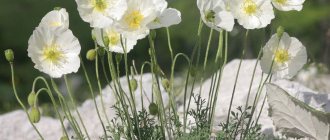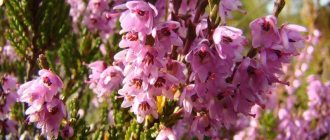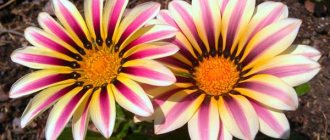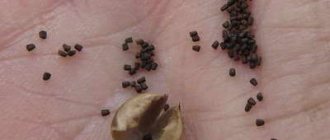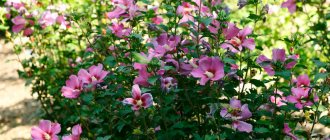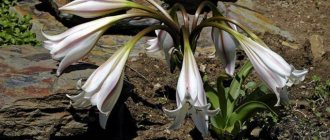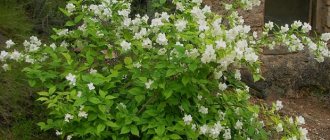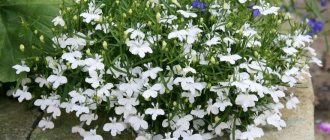Description and characteristics
Cornflowers are a genus of herbaceous plants of the Asteraceae family. They began their history of garden plants as ordinary weeds in fields sown with rye. People liked the plant for its unusual beautiful flowers and began to be cultivated around the middle of the 16th century. Since then, many species have been selected from dwarf specimens to giants about 80cm high.
Cornflowers (Latin centaurus from the Greek Κένταυρος) are a plant with an unusual history. According to the mythological version, it got its name due to the fact that the centaur Chiron (the son of Kronos and Philyra, who had immortality) was healed with its help from the poison of the Lernaean Hydra (the daughter of Typhon and Echidna, who was later killed by Hercules). Although the name Centaurus has been known since the times of ancient Greece, according to the rule of the International Code of Botanical Nomenclature, all plant names approved before May 1, 1753 are considered invalid. And the official authorship belongs to Carl Linnaeus.
Popularly, the flower can be called: boletus, commotion, voloshka or blue flower. Nowadays, about 550 varieties of cornflower are known, which grow in Europe, America and Asia. The classic flowers of this family are the Frosty Mix cornflower, which is unpretentious, has a variety of colors and grows up to 80 cm.
Application in landscape design
Varieties of garden violas, bred as a result of breeding work, are distinguished by lush greenery, a variety of colors and rather large corollas, but at the same time they continue to retain the charm of forest flowers.
Their enviable advantages include:
- Unpretentiousness in content;
- Ability to grow as ground cover;
- And the possibility of long-term and repeated flowering.
Therefore, varieties of garden violets are suitable for creating absolutely any landscape shape. They look great in prefabricated flower beds, flower beds, borders and lawns.
With their help, you can create a variety of alpine slides and multi-colored curtains for decorating park areas. Garden violas also serve as an excellent material for creating borders and vertical compositions.
IMPORTANT! Garden violets can be used both as independent decoration objects and in various combinations with other cultivated and forest plants.
Methods of propagation of varieties
Like most breeding flowering grasses, cornflowers are either annual or perennial. Annual cornflowers are grown from seeds, while perennial cornflowers are mostly transplanted. Gardeners prefer perennial varieties that can grow in the same place for up to 10 years.
All the numerous varieties of centaurus are divided into:
- Xerophytes . Steppe varieties, accustomed to heat and arid climate. Xerophytes include Blue Cornflower, Amberboa musk, etc. Xerophytes have a massive tap root and are able to go quite deep into the soil in search of moisture.
- Mesophytes . More delicate meadow flowers that prefer slightly moist soil. The flowers of this group are mainly annual: Lugovoi cornflower, Myagky cornflower, Phrygian cornflower, etc. The acidity of the soil for growing these species is recommended to be neutral.
Caring for cornflowers
Cornflowers require moderate watering, since they cannot tolerate stagnation of excess moisture. These plants are not too demanding on the composition of the soil, but they develop better in fertile soils that have neutral acidity. For favorable development of plants, it is necessary to periodically loosen the soil and remove excess weeds from the territory occupied by cornflowers. Cornflowers are fed once every fifteen days using complex fertilizers. In the autumn, additional feeding of plants is also necessary, this will increase the winter hardiness of cornflowers and make it easier for perennial plant varieties to withstand prolonged frosts.
Planting seeds in open ground
It is not necessary to make seedlings for cornflowers - they sprout well when planted immediately in open ground.
- The soil must be loosened and holes made for seeds about 1.5 cm deep.
- The distance between the holes for large varieties is 5-10 cm - at this distance, the flowers will support each other when they grow.
- For low-growing varieties, it is recommended to maintain 20 cm between holes - low-growing varieties tend to bush and grow wider.
If the bushes do not have enough space to grow, they begin to degrade, the stems become thinner, and the buds become small and faded.
How to care for flowers
Even such an unpretentious plant needs to be looked after. Then you will extend its life and can enjoy flowering for a long time.
Watering, weeding and loosening
Cornflowers do not like abundant moisture. Therefore, in rainy summers it is quite possible to do without additional watering. In dry weather, you need to provide watering to moisten the soil, but try not to overdo it.
Site selection and soil preparation
When choosing a place for sowing, you should pay attention to several basic conditions:
In their natural environment, wild cornflowers grow in open fields and do not need protection from the hot sun. The place for sowing them on the site should be open and preferably without shade.
The large difference in height and size of different varieties is also taken into account when choosing a growing location. Tall specimens are usually planted in the background of the flower bed, while lower ones are used for decoration or in front of their taller counterparts.
Cornflowers themselves are variegated and multi-colored, and if you plant them among other similarly variegated species, the flowerbed may end up being too chaotic. It is best to combine them with solid colors.
To complete the landscape design, it is recommended to choose a plain background for the seedlings. A green shrub or hedge works well.
All varieties of cornflower are fairly unpretentious flowers that grow in any soil. But if you fertilize the soil, flowering will begin a little earlier and will be noticeably more luxuriant.
Growing terry cornflower from seeds
This flower is an annual plant; it is planted using the seedless method, sowing the seeds directly into the ground. When is the best time to plant seeds? The optimal time for this is considered to be the end of April or the beginning of May.
Growing cornflower from seeds should take place in a sunny place. This flower prefers soil:
- well drained;
- non-acidic;
- sandy loam.
It is generally accepted that on alkaline soil the cultivation of these plants from seeds is much more intensive, and their color becomes brighter. If the soil is clayey, sand should be added to it, and lime should be added to acidic soil before planting cornflowers, and this must be done before the onset of winter.
How to plant cornflowers
Since centaurus is a flower with a tap root, excessively loose soil must be compacted a little before planting to make it more dense. Otherwise, the roots may have difficulty gripping the soil if there are many voids in it, and the flowers will develop worse. It was written a little higher about the need to loosen the soil, but this only applies to the top layer to prevent stagnation of water after watering and to ensure air access to the roots.
Annual and perennial cornflowers are sown according to the same principle, with the only difference being that annual cornflowers are flowers that are constantly grown from seeds, while perennial cornflowers are grown from seeds only for the first time and are subsequently replanted.
At the end of the flowering period of annual varieties, a seed box ripens in place of the bud, which can be collected. Seeds should be stored in a dark, dry and cool place, preferably in a ceramic container and dried periodically. So the seeds can be collected and used to replant flowers for 3 years in a row, after which the germination rate begins to fall.
Lighting
Cornflowers not only love the sun, but also tolerate heat and drought well. In addition to the fact that they should not be planted in the shade, it is best to plant these flowers so that other plants do not darken them either. Lack of sunlight can have a detrimental effect on the growth and flowering of the centaurus, as well as weakening it and making it more susceptible to disease.
Feeding the flower
You can feed flowers during the formation of buds. Urea and nitrophoska are good for feeding - 20 g of fertilizer is diluted in 10 liters of water. The consumption of fertilizer solution for irrigation is approximately 3-4 liters per 1 m² of flower bed.
There is another, stronger product that can be used in combination with other fertilizers - this is the drug Zircon. Zircon is diluted in proportions of 1 ml per 1 liter of water and sprayed onto flowers shortly before the formation of buds. One liter of solution is enough to treat about 30 m².
Watering rules
Cornflowers do not like standing water; they should be watered moderately - excessive watering can destroy the plants. If the water stagnates after watering, you can carefully loosen the top layer of soil. Some varieties need very little moisture, while others need a little more - find out the characteristics of your variety in advance, before planting.
Trimming
In order to care for the flowerbed so that it looks neat with each new season, at the end of the flowering season, dried stems are cut off. This does not affect the plants themselves in any way and is done only for aesthetic reasons. Also, if the plant is perennial, then over a few years old shoots can heavily litter the bush and complicate any interaction with it.
Where and in what areas are perennial cornflowers used?
But not only gardeners love this crop. Cornflowers are used in a number of other areas:
- Medicine: classical and folk. In classical medicine, cornflowers are used to treat diseases of the eyes, liver and bile ducts. Used as part of an antiseptic to disinfect wounds and fractures. In folk medicine, infusions are made from cornflowers, which are used as a diuretic. Also, tinctures of certain types of cornflower help with coughs and other colds, as well as for the prevention of ARVI.
- Gynecology. A decoction of cornflower brings the menstrual cycle back to normal.
- Cosmetology. The decoction can help relieve some temporary skin problems such as eye bags, enlarged skin pores and allergic reactions.
How to grow seedlings
How to grow seedlings? Sowing of seedlings is carried out mainly in early April:
- The container for seedlings is filled with earth and compacted a little (as when planting in the ground).
- Small holes of 1-2 cm are made in the ground and moistened with water.
- The seeds are placed in the holes and sprinkled with soil (there is no need to compact the soil again).
- The finished container with planted seeds is wrapped in film to create a greenhouse effect.
- The container is stored in a sunny place at a temperature of about 22 °C.
- After the shoots emerge, the film is removed.
- The sprouts are fed with a special complex fertilizer for seedlings (one time).
- When the sprouts reach 10 cm, they are transplanted into open ground. Cornflowers do not respond well to transplantation, so it is best to replant them together with the soil in which they grew.
Care after landing
Usually the seeds do not need additional processing, but for Fischer's cornflower and field cornflower, dry stratification is necessary. Without this procedure, the seeds will not sprout. They are placed in plastic bags and placed on the top shelf of the refrigerator at a temperature of +1 to +5 ° C for 1–2 months before sowing in open ground or for seedlings. When planting before winter, stratification is not required.
In April–May, beds are formed on the site. The dug up soil is leveled, pressed down a little and furrows 2–3 cm deep are made.
The soil is moistened abundantly and dry or prepared seeds are planted at a distance of 5–10 cm. They are sprinkled with sifted soil on top. After this, the area is covered with a special cloth. The beds are watered every 2 days.
The first shoots appear within a week, after which the covering material is removed.
After a few days, the sprouts are thinned out, leaving 10–20 cm between them. You need to ensure that adult bushes grow freely, without interfering with each other.
Top dressing
Cornflowers are fed before flowering. To do this, take 10 liters of water and dissolve 1 tbsp in it. l. nitrophoska and urea. Water the soil under the plants with the prepared fertilizer, using 3–4 liters of the product per m². We must remember that excessive feeding leads to yellowing of the leaves.
To make the buds bloom faster, use the drug “Zircon”. In accordance with the instructions, the bush is sprayed with it before flowering.
Watering
The plants are unpretentious and need water only in severe drought.
If the leaves of the cornflower begin to fade and the flowers become smaller, this means that it does not have enough moisture. It is best to install an automatic sprinkler on the site, which can be turned on daily for a few minutes.
In rainy summers, the bushes are not watered, because for them, waterlogging is more dangerous than lack of moisture.
Trimming
To make the plants look beautiful and aesthetically pleasing, faded shoots are removed during the summer. Pruning is carried out in two ways: high and low. In the first case, the dried inflorescences are removed, and in the second, the stem is removed 10 cm from the ground. Summer residents recommend top pruning to make the bush look fluffier and neater. Low results in the appearance of bald spots in the flowerbed.
Rhizome division
Although perennial plants grow on their own, to prevent them from getting sick due to the increased density of bushes, it is recommended to periodically weed them from excess plants and replant them. This is done at the end of summer, usually in August:
- An adult bush is carefully dug out along with the soil so as not to damage the roots.
- The roots are washed from the ground in a container convenient for you: in a basin, in a bucket, etc.
- After washing, the large bush is divided into several bushes so that each new one has its own full root, several healthy shoots and at least 3 buds.
- The root of each resulting bush is cut off so that its length does not exceed 10 cm. This stimulates the development of new plants.
- Subsequently, planting in open ground occurs according to the principle described above: a small depression is made in the ground, the soil in the depression is slightly soaked with water, the plant is planted in the resulting hole and sprinkled with earth.
If everything is done correctly, then flowering can be expected next summer.
Cornflowers in folk medicine
Even if you are not planning to grow this plant yet, you definitely need to know what cornflower looks like. The fact is that this peduncle is used in gynecology, folk medicine, and is actively welcomed by cosmetologists. Since ancient times, healers have used it as a diuretic and choleretic agent. Decoctions help with severe cough and nephritis, gastrointestinal diseases and nervous system disorders. Women know that cornflower infusion helps normalize the menstrual cycle and enhances lactation. In cosmetology, a decoction is used internally if the pores of the face are greatly enlarged, in case of swelling of the eyes, and so on.
{SOURCE}
Pests and diseases of cornflowers
If you follow all the few rules of care, the flowers should not get sick. The most common disease that can affect cornflowers is fusarium. Fusarium is caused by anamorphic ascomycete fungi Fusarium, which is somewhat reminiscent of mold in its effects. The mycotoxins that these fungi produce during their life processes destroy the diseased centarus.
The disease can affect any part of the flower, but basically it all starts with yellowed leaves. It is best to remove infected areas immediately, treat all flowers with a fungicidal preparation, sprinkle the flowers themselves and the soil in which they grow with ash.
